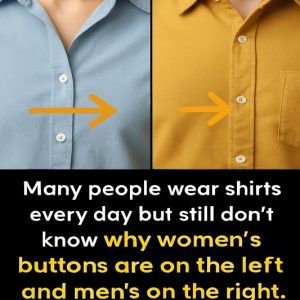The difference in button placement between men’s and women’s shirts is a subtle detail many people overlook, yet it reflects centuries of history and social influence. Women’s shirts fasten on the left, while men’s fasten on the right, a tradition that dates back to the 18th and 19th centuries when fashion was closely tied to class and practicality. At that time, upper-class women rarely dressed themselves; their elaborate clothing often required the help of maids. Since most people were right-handed, placing buttons on the left made it easier for a servant to fasten the garment while facing the wearer. What began as a practical solution gradually became a fashion norm, evolving into a symbol of femininity, elegance, and social status.
The left-button convention for women subtly indicated wealth, refinement, and the luxury of having assistance. Over time, even as society changed and women increasingly dressed themselves, the tradition persisted as a cultural and stylistic expectation. It became less about utility and more about fashion, a silent nod to history that has endured through centuries of changing clothing trends. Designers and tailors continued to follow this pattern, embedding it as a standard of women’s apparel that remains today.
Men’s clothing developed under entirely different pressures. In earlier centuries, men commonly carried swords or other weapons on their left side, enabling quick access with the dominant right hand. Right-side buttons allowed men to unfasten their garments efficiently in situations requiring speed or defense. This practical arrangement, rooted in necessity, gradually became an entrenched aspect of men’s fashion. Beyond convenience, it came to signify discipline, readiness, and masculine identity, reflecting both functional and societal expectations for men.
As military influence spread to civilian life, the right-button convention solidified further, contrasting sharply with women’s left-buttoned attire. Whereas women’s clothing often emphasized status and decorative appeal, men’s attire highlighted practicality and preparedness. These distinctions illustrate how fashion not only meets functional needs but also communicates social roles, gender norms, and historical priorities. Even minor details like button placement carry deep cultural resonance.
Today, neither servants nor swords dictate clothing design, yet the historical conventions persist. A simple shirt still carries the imprint of centuries-old habits, signaling the influence of gender, class, and practicality in everyday life. The placement of buttons is more than a functional choice—it is a living trace of social history





